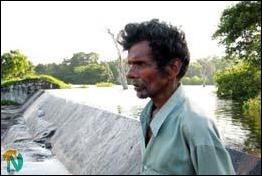
Udumbankulam survives mass murder, forced eviction
[TamilNet, Wednesday, 19 February 2003, 21:30 GMT]
In Udumbankulam, a minor Tamil hamlet in the little
known interior of Sri Lanka’s southeastern coast, the
fields are densely green where 17 years ago on
February 19, 1986 the Sri Lankan military hacked and
beat to death 128 farmers on the village’s threshing
floor. The area is being gradually retrieved from the
clutches of the jungle. A handful of intrepid former
residents who returned to the village five months ago
are eagerly looking forward to a bumper crop of rice.
But Feb 19 remains an indelibly bitter day for them.
As often is the case, the Sri Lankan government did
nothing to investigate the mass murder of
Udumbankulam.
 |
|
Kanapathipillai Sivanesarajah, 58, looks over his field, standing near the Udumbankulam reservoir's spill.
|
“I escaped the massacre because I was out on business
that day. Everyone was scared. We were able to get
here only the next day. The threshing floor was full
of burnt and half burnt bodies. It was an unbearable
sight. A boy who escaped and hid in the jungle told us
that some of the victims were alive when the soldiers
set them on fire. Exactly five months later the
military came here again and shot dead two men from
the village, on 19 July 86”, said Nakamany Kandasamy,
48, the local headman.
Three years after the gruesome massacre, those
villagers who dared to remain in Udumbankulam were
driven out en masse by the elite counter insurgency
arm of the Sri Lankan military the Special Task
Force (STF).
 |
|
Krishnan Sivajothy beating a sheaf of paddy on the threshing floor of a field in Thangavelauthapuram.
|
“STF commandos burnt our house and shop in 1990. They
destroyed the village school and co-operative society
building too. The STF set fire to our harvested paddy
and destroyed 25 thousand manioc plants in our farm
which we had planted for the season. My husband and I
barely escaped death. We hid in the jungles for many
days. We have come back here after 12 years. But
starting life all over again is very hard”, says
Kumarakulasingham Thangeswary, 45.
“But worst of all is that the STF blew up the bunds of
water reservoirs here. The reservoirs have remained
breached for almost a decade. The Tamil Eelam Economic
Development Organisation (TEEDOR) has helped repair
the bund of the Udumbankulam reservoir. Other the
breached bunds of the other minor tanks (reservoirs)
have also been repaired in recent months”, said the
President of the Rural Development Society for the
area, Mr. Murugesu Varatharajan, 33.
He said families are reluctant to resettle on a
permanent basis because even the rudimentary
infrastructure needed to sustain human habitation has
been systematically and ruthlessly destroyed in the
STF’s counter insurgency operations in the region.
 |
|
Nakamany Kandasamy, 48, on his way to Udumbankulam at dusk.
|
“To many of our people who go about in luxury
vehicles, discussing the reconstruction of our
homeland with foreigners, we are just an inconspicuous
dot on the map. Pregnant women have to walk more than
eight kilometres from here to get a bus to
Thirukkovil”, he adds bitterly.
“We had to break granite stones for a living. We could
not cultivate the lands here and my family is still
sunk in poverty. Three meals a day is a luxury for my
family”, says Krishnan Sivajothy, 38, as she beats
with a stick a sheaf of paddy she and her friends had
been allowed to collect from the floor of a harvested
field in Thangavelauthapuram, a village near
Udumbankulam.
“A hard day’s work gets us enough grains of rice to
give the children a square meal”, she said.
Sivajothy and her colleagues are from the village of
Thandiady, about 94 kilometers south of Batticaloa, on
the main road along the island’s southeastern coast.
The STF held the village for more than decade, like an
open prison,
human rights activists in Batticaloa say.
Indiscriminate arrest, detention, torture and
disappearance were rampant here. No journalist has
been to the area since the STF took control more than
18 years ago.
Thousands of families which were driven out almost
overnight as part of the STF’s counter insurgency
strategy designed according to western manuals on the
subject, lived as refugees for more than 12 years in
the villages of Thirukkovil and Thambiluvil, 76
kilometers south of Batticaloa. Many were driven to
destitution and despair as the STF continued to deny
access to their fertile lands and cattle herds.
Those who dared to go back were shot dead by STF
patrols in ambush.
However, the STF’s decade long counter insurgency
measures, successfully tested and honed over the years
in other parts of the world, neither curbed the
military activities of the Liberation Tigers nor
succeeded in scaring the population away from the
Tigers.
Instead, the scorched earth policy which successive
government’s tacitly promoted in the region evolved
into a cover to the STF for a perpetuating a
comfortable way of corrupt life, which the terrorized
population was forced to pay dearly for.
“We had to lose a few people. But public protests here
since the signing of the ceasefire have shown the STF
that our people cannot be treated like slaves for
ever”, says Vivekanandan, a social activist and
journalist in Thirukkovil.
 |
|
Twilight over the Udumbankulam Tank.
|










